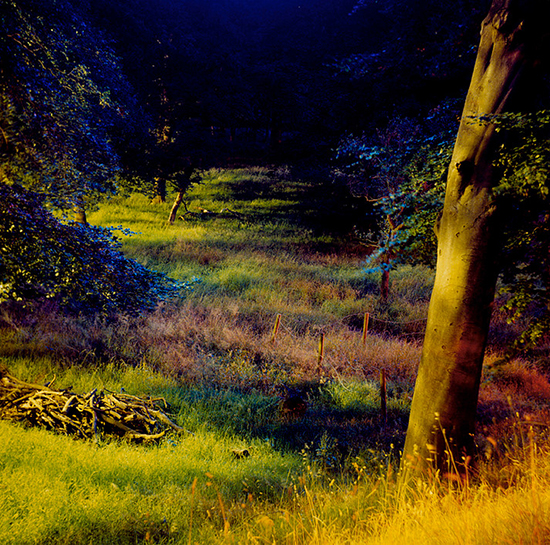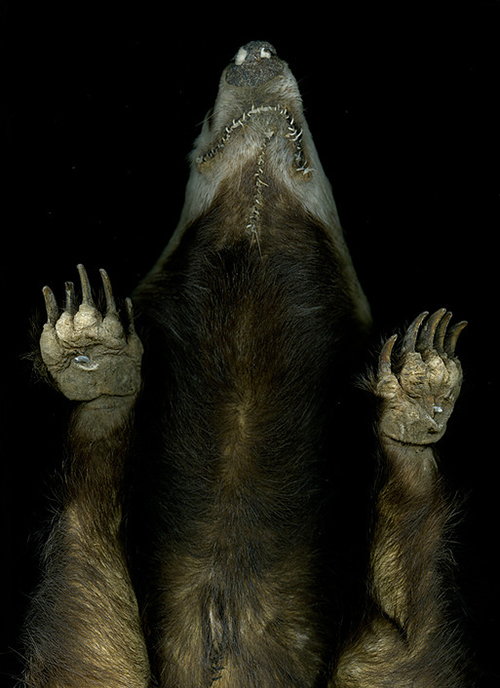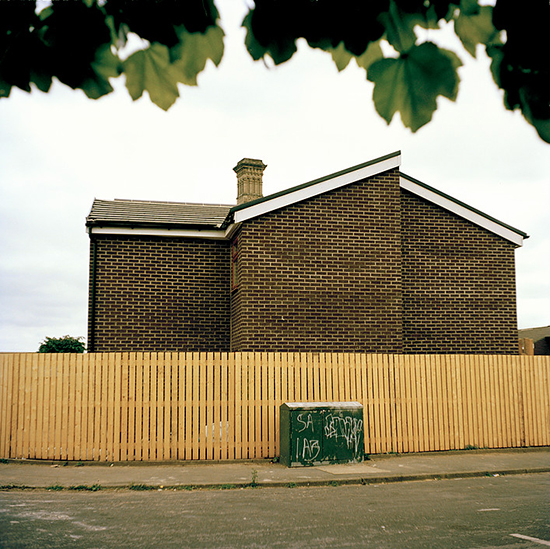| SIMON DENISON IMAGE & TEXT |
| PREVIOUS | NEXT |
LIZA DRACUP: FIELD WORK Impressions Gallery, Bradford
Impressions Gallery re-opened in Bradford in 2007 with Bradford-born photographer Liza Dracup’s first major project, Sharpe’s Wood, and has now marked its tenth anniversary in the city with Field Work, a survey of her work over the past ten years. The exhibition selects from five bodies of work consisting of three major strands: night-time Yorkshire landscapes made using long exposures, studio images of locally-found taxidermy specimens and plants, and topographic images made in the city of Bradford. If there is something of a local flavour to this show, it is intentional: Dracup is explicit about her commitment to photographing her local region, emphasizing the ‘cultural value of the ordinary and the local’. What is ordinary is not presented as ordinary, however. Dracup has used photography to transform her subject matter since her earliest work, in which Sharpe’s Wood on the edge of the city was turned by streetlamps, headlight beams, moonlight, time and photographic chemistry into a fairyland of tinted dells and coloured fronds. In her later work, transformation is generally less overt, although still explicitly intended. In Re:Collections, small taxidermy specimens from Bradford Museums are imaged against a black background. The extent of transformation is made plain by a display-table near the images containing real taxidermy specimens which, with a hint of Brechtian theatre, ‘lays bare the device’ of the photography, revealing its artifice. In the cabinet, the specimens are muted in colour, dry, evidently lifeless objects, impaled on their stick handles; while in the photographs, isolated and lit in a depthless space, and with contrast and tonality fine-tuned in post-production, the stuffed creatures – while clearly not alive – acquire a certain vibrancy. The significance of this transformation is, however, moot. Gallery statements indicate that the work intends us to question our relationship with the animal kingdom; and these images of wildlife doubly defamiliarized, by taxidermy and photographic staging, are certainly suggestive. Some bring to mind – one might say, accusingly – the butcher’s slab, others, items of fur clothing; some simply draw attention to the intricate patterning and colour of feather or pelt, to the creature’s remarkableness and otherness. I was particularly mesmerised (and repelled) by the strikingly non-human paws of Dracup’s badger, ‘palms’ held forward to the lens, gnarled and puffy with their single broken claw. Even so, the Brechtian display-table – no doubt unintentionally – works to undermine any behaviour-questioning train of thought, reminding us of the manipulative rhetoric of all visual culture, this show included. These two opposing communicative forces do not quite cancel each other out, but co-exist in a state of unresolved tension. Sharpe’s Wood was widely exhibited and Dracup’s success with it led to a number of night-time photography sequels: Chasing the Gloaming consists of images made between Whitby Bay and Leeds, and Landmarks includes further Yorkshire landscapes. The two bodies of work are said to be inspired, respectively, by the Victorian moonlight paintings of John Atkinson Grimshaw and by items in the Harrogate Fine Art Collection. However, the source material is not presented so the rationale for the referencing, and the nature of the response, are not clear. In most cases the subject matter and framing are conventional: woodland, coastal scenes and seascapes, rivers, and illuminated city bridges crossed by light-trails from passing vehicles. The distinctive element here is the tonality created by night-time conditions, the long-exposure process and its consequences for the registration of colour. This can range from the skittish peculiarities of the earliest work to a tonal flatness indistinguishable from the dullest of daylight, and all points between. A question to address – because Dracup raises it herself – is over the relationship of her brand of photographic seeing to ‘hidden reality’. In a statement on her website, she refers to a desire to reveal what is ‘hidden and unseen’ in order to produce an ‘enriched idea of the northern landscape and its natural history’. In Sharpe’s Wood, for example, the gallery tells us: ‘She aims to reveal the vibrant hidden landscapes that lie beyond what can be seen by the human eye’. Similar claims about the camera’s penetrating vision were made by Modernists such as Edward Weston; but they seem harder to sustain now without elaborate nuancing. Photographs may draw attention to what is missed by the naked eye, in terms of appearances and what can be deduced from them. However, whether a single-image registration of reflected light gathered up over several hours has any real-world referent that has escaped our notice is, perhaps, one for the philosophers to answer. There is certainly a direct opposition between the view that photography reveals reality (hidden or not) and Dracup’s recognition that it transforms whatever it touches – the difference between showing a thing as it is, and as it is not. Either view might be advanced, but the contradiction needs to be reconciled, and no attempt is made to do so here. Lister’s Mill: A Topographical View is Dracup’s contribution to the ongoing work of photography collective Bradford Grid, and it is so different from her other work as to appear extra-curricular. In this survey project – modelled on a similar project in Portland, Oregon – the city map has been divided using a square mile grid, and photographers in the group document these patches as they see fit. Dracup’s images focus on the tall chimney of the former silk mill of the title, viewed from all angles and distances. Some will find this her most engaging work, because it is least dependent on photographic process for effect. Like most topographic photography, the work cannot help being intriguing for its indexicality, and her images are well-seen. Viewing the images in sequence, we appear to wheel around the city as if on the chimney’s pivot. It is an admirable project: it would be good to see the format adopted in cities elsewhere. |
 |
|---|---|
 |
|
 |
|
| Images: Sharpe's Wood (top), Re:Collections (middle), Lister's Mill (bottom) | |